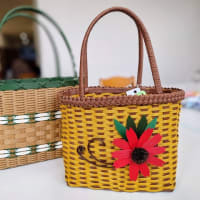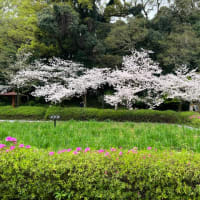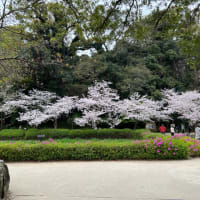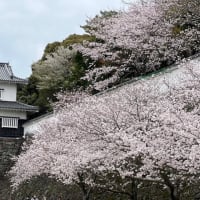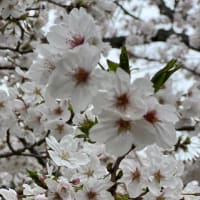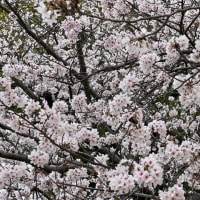少し遅くなりましたが、11月4日にセミナーがありました。
自然療養を学ぼう!とあり、どんなことなのか興味津々
朝10時位から15時位までしっかりと受講してきました。
場所は、東そのぎ自然農園。太陽ファームもそこにあります。

詳しくはこちらをご覧ください。
午前中は田中リョウスケさんから畑の説明
この農法は炭素循環農法といい、通称たんじゅん農法と言われてます。
600坪2段の畑を掘り起こし、その後3人で耕し畑を作る。
この作業は約2か月かかったそうです。

頑張った3人、太陽工房の職員です。
畑には、えのきだけの菌床を耕した土の上全体に敷き
水はけがよくなるように、山林の村道を整備した時に出る
産業廃棄物(木くずや腐葉土枯草等)を畑の通路に敷いてあります。
2mおき45cm間隔にチップが置かれています。


近くから見るとこんな感じです。歩くとフカフカしています。
畑を見ながら、参加者の皆さんから質問を受け田中さんが答える形で
進んでいきました。その質問の中で印象に残ったことを一つあげると
畑の畝(うね)に雑草があるところと、ないところがあるがなぜか?という質問

左側と右側、違いがわかりますか?
に対して、雑草が生えているところは土の中に草(枯草や雑草など)を入れていないところ。
それに対して、雑草が生えていない畝は逆に畑の土の中に草を入れて畝を作っている
というこだそうです。なぜでしょう、不思議ですね。
雑草は人間からみれば不必要に見えますが、自然の摂理の中では
しっかりとその役割があるのでしょうね
それを私たちが理解してうまく使ってあげることは大切だと思いました。
科学的根拠?・・・それは私の能力では説明できませんので
調べてみてください。田中さんの言葉をおかりすると、
なぜ?ではなくそうなんだと理解すること。自分のこれまでの畑の知識を
畑に当てはめるのではなく、畑から学ぶ。というようなことを語っておられたのが
とても印象に残りました。
畑の土を手に取って見ると、表面は乾いているけれど、中からしっとりした土が出てきます
触っていてとても気持ちがいいです。
雨が降ったら畑に入らずに、土を触って状態を見ながら畑に入る時期を見極めるそうです
実際に経験しながらなんでしょうね。
水遣りは一切せず、草も生えにくいが作物が育っているところは草が生えてくるので
手入れとして草取りはする。しかし、2日に一回、1日2時間程度の作業だったそうです。
こうして実りがあるけれども、特に何もしていない。

う~ん 従来の無農薬野菜のイメージとは違いますね。
参加した各人、畑の作物をいただき自宅用に。中には畑から抜いて土を払い
そのまま食べていた人もいました。(実は私も・・・)
ほうれん草は全然あくがなく、食べた人たちが「これはサラダほうれん草ね」なんて
言ってましたが、普通のほうれん草だそうです。
水菜・ほうれん草・小松菜・カブ・大根・春菊・など季節の野菜が実ってました。
後日、春菊をサラダにして生で食べましたが風味がありくせがなく美味しくいただきました。

参加者も結構いらっしゃいました。農家の方が多かったようですが、小さな子どもがいる若いお母さんもいらっしゃいました。
この後は、場所が東そのぎに移り、養生食の話になります。
つづく
It’s a little late to announce, but we had a lecture on November 4th.
It said “Learn naturopathy!” so I was excited.
I had a lecture from 10am until 3pm.
The place was Higashisonogi Natural Farm. Taiyo farm’s also there.
For more detail check the link out.
In the morning, we had an explanation of the field from Mr. Ryousuke Tanaka.
It is called carbon cycle farming, CCF for short.
Dug out the 200 square meters, 2nd grade terraced field, and plowed it to make a nice field.
They said it took two months to be done.
The three people worked hard, all of them were Taiyo Koubou’s employees.
Spread enokidake mushrooms’ bed all over the cultivated field, and lay out the industrial waste that come out when we maintain the forest to be well drained on the aisle of the field.
Leave every 2 meters and a space of 45 centimeters.
It is like this if you took a closer look. It fluffy if you walk.
It went like Mr. Tanaka answering questions from the participants looking at the field.
On the other hand, the thing I remember clearly was why there are the places which there are ridges and there are the places that aren’t ridges.
Can you find the differences of the left side and right side?
Where weeds are grown is not putting grass in the soil.
However, the ridges where weeds are not grown, putting grass in the soil of the field. I wonder why, it’s mysterious.
Grass is unnecessary for humans but in the law of nature it has a particular role.
I think it is important to understand and use it meaningfully.
Scientific basis? … It is out of my capacity to explain it, so please search for yourself.
If I borrow Mr. Tanaka’s words it’s not “it’s not why?”, just understand what it is. Not applying to the field, learn from the field. Those words were so impressive.
If you put up the soil of the field, it’s dry on the surface, but it’s moistly inside, it feels very good to just to touch it.
If it rains not to go on the field, watch the situation of the soil and decide when to go on to the field.
Experiences might be required.
Not to water it, it’s not easily to grow grass, but around the crops grass grows so take care of the grass.
However, once in 2 days, it’s about 2-hours work in a day.
It grows but we don’t do anything special.
Umm, it’s different from the old style pesticide-free vegetables.
Participants received vegetables. Some were eating vegetables brushed off the soil.
Spinach wasn’t bitter taste, so some people who ate the spinach said “This is salad spinach.”, but it was natural spinach.
Mizuna (potherb mustard), spinach, komatsuna (a kind of colza), turnip, Japanese radish, crown daisy, and so on, these kinds of vegetables were grown.
The day later, we ate crown daisy as salad, but it has a taste and no peculiar we enjoyed eating it very much.
There were a lot of farmer, but also there were mothers who have little kids.
After this, we moved to Higashisonogi comprehensive hall and the story continues about the curing diet. To be continued.
自然療養を学ぼう!とあり、どんなことなのか興味津々
朝10時位から15時位までしっかりと受講してきました。
場所は、東そのぎ自然農園。太陽ファームもそこにあります。

詳しくはこちらをご覧ください。
午前中は田中リョウスケさんから畑の説明
この農法は炭素循環農法といい、通称たんじゅん農法と言われてます。
600坪2段の畑を掘り起こし、その後3人で耕し畑を作る。
この作業は約2か月かかったそうです。

頑張った3人、太陽工房の職員です。
畑には、えのきだけの菌床を耕した土の上全体に敷き
水はけがよくなるように、山林の村道を整備した時に出る
産業廃棄物(木くずや腐葉土枯草等)を畑の通路に敷いてあります。
2mおき45cm間隔にチップが置かれています。


近くから見るとこんな感じです。歩くとフカフカしています。
畑を見ながら、参加者の皆さんから質問を受け田中さんが答える形で
進んでいきました。その質問の中で印象に残ったことを一つあげると
畑の畝(うね)に雑草があるところと、ないところがあるがなぜか?という質問

左側と右側、違いがわかりますか?
に対して、雑草が生えているところは土の中に草(枯草や雑草など)を入れていないところ。
それに対して、雑草が生えていない畝は逆に畑の土の中に草を入れて畝を作っている
というこだそうです。なぜでしょう、不思議ですね。

雑草は人間からみれば不必要に見えますが、自然の摂理の中では
しっかりとその役割があるのでしょうね
それを私たちが理解してうまく使ってあげることは大切だと思いました。
科学的根拠?・・・それは私の能力では説明できませんので

調べてみてください。田中さんの言葉をおかりすると、
なぜ?ではなくそうなんだと理解すること。自分のこれまでの畑の知識を
畑に当てはめるのではなく、畑から学ぶ。というようなことを語っておられたのが
とても印象に残りました。
畑の土を手に取って見ると、表面は乾いているけれど、中からしっとりした土が出てきます
触っていてとても気持ちがいいです。
雨が降ったら畑に入らずに、土を触って状態を見ながら畑に入る時期を見極めるそうです
実際に経験しながらなんでしょうね。
水遣りは一切せず、草も生えにくいが作物が育っているところは草が生えてくるので
手入れとして草取りはする。しかし、2日に一回、1日2時間程度の作業だったそうです。
こうして実りがあるけれども、特に何もしていない。

う~ん 従来の無農薬野菜のイメージとは違いますね。

参加した各人、畑の作物をいただき自宅用に。中には畑から抜いて土を払い
そのまま食べていた人もいました。(実は私も・・・)
ほうれん草は全然あくがなく、食べた人たちが「これはサラダほうれん草ね」なんて
言ってましたが、普通のほうれん草だそうです。
水菜・ほうれん草・小松菜・カブ・大根・春菊・など季節の野菜が実ってました。
後日、春菊をサラダにして生で食べましたが風味がありくせがなく美味しくいただきました。

参加者も結構いらっしゃいました。農家の方が多かったようですが、小さな子どもがいる若いお母さんもいらっしゃいました。
この後は、場所が東そのぎに移り、養生食の話になります。
つづく
It’s a little late to announce, but we had a lecture on November 4th.
It said “Learn naturopathy!” so I was excited.
I had a lecture from 10am until 3pm.
The place was Higashisonogi Natural Farm. Taiyo farm’s also there.
For more detail check the link out.
In the morning, we had an explanation of the field from Mr. Ryousuke Tanaka.
It is called carbon cycle farming, CCF for short.
Dug out the 200 square meters, 2nd grade terraced field, and plowed it to make a nice field.
They said it took two months to be done.
The three people worked hard, all of them were Taiyo Koubou’s employees.
Spread enokidake mushrooms’ bed all over the cultivated field, and lay out the industrial waste that come out when we maintain the forest to be well drained on the aisle of the field.
Leave every 2 meters and a space of 45 centimeters.
It is like this if you took a closer look. It fluffy if you walk.
It went like Mr. Tanaka answering questions from the participants looking at the field.
On the other hand, the thing I remember clearly was why there are the places which there are ridges and there are the places that aren’t ridges.
Can you find the differences of the left side and right side?
Where weeds are grown is not putting grass in the soil.
However, the ridges where weeds are not grown, putting grass in the soil of the field. I wonder why, it’s mysterious.
Grass is unnecessary for humans but in the law of nature it has a particular role.
I think it is important to understand and use it meaningfully.
Scientific basis? … It is out of my capacity to explain it, so please search for yourself.
If I borrow Mr. Tanaka’s words it’s not “it’s not why?”, just understand what it is. Not applying to the field, learn from the field. Those words were so impressive.
If you put up the soil of the field, it’s dry on the surface, but it’s moistly inside, it feels very good to just to touch it.
If it rains not to go on the field, watch the situation of the soil and decide when to go on to the field.
Experiences might be required.
Not to water it, it’s not easily to grow grass, but around the crops grass grows so take care of the grass.
However, once in 2 days, it’s about 2-hours work in a day.
It grows but we don’t do anything special.
Umm, it’s different from the old style pesticide-free vegetables.
Participants received vegetables. Some were eating vegetables brushed off the soil.
Spinach wasn’t bitter taste, so some people who ate the spinach said “This is salad spinach.”, but it was natural spinach.
Mizuna (potherb mustard), spinach, komatsuna (a kind of colza), turnip, Japanese radish, crown daisy, and so on, these kinds of vegetables were grown.
The day later, we ate crown daisy as salad, but it has a taste and no peculiar we enjoyed eating it very much.
There were a lot of farmer, but also there were mothers who have little kids.
After this, we moved to Higashisonogi comprehensive hall and the story continues about the curing diet. To be continued.














